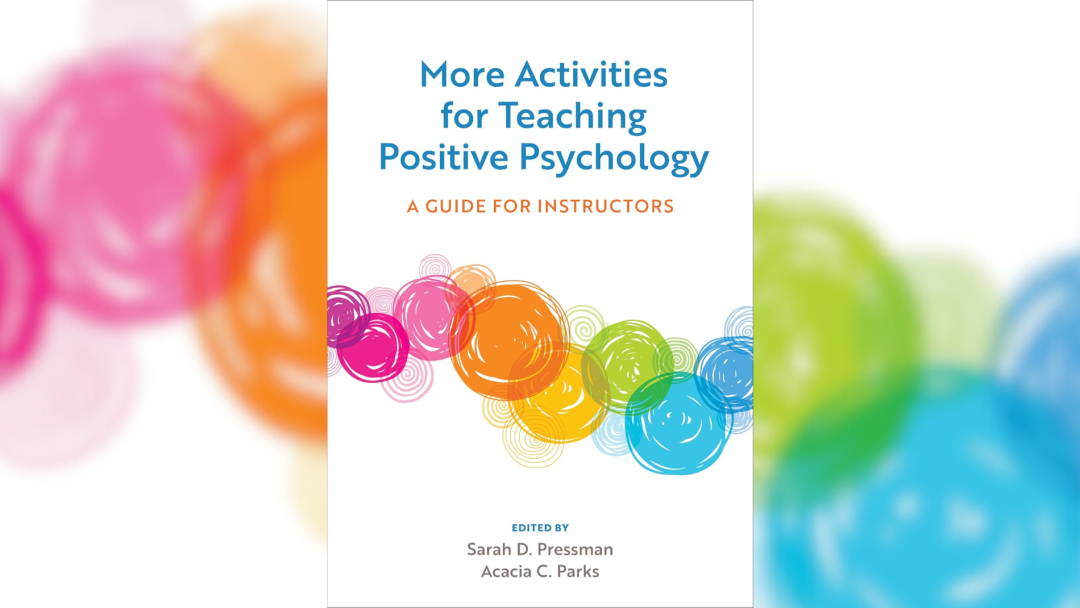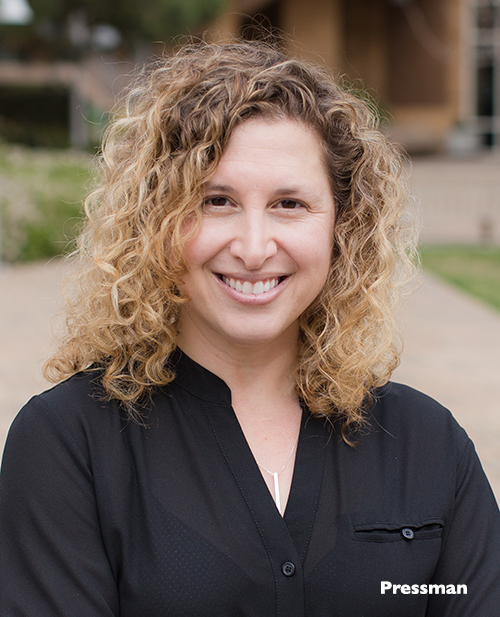
Sarah Pressman’s new book is for instructors, but you should read it, too
As if Sarah Pressman is not busy enough, the UC Irvine professor of psychological science, principal investigator of The STEP (STress, Emotion & Physical health) Laboratory and associate dean of student success with the UCI Division of Undergraduate Education jumped at the American Psychological Association’s offer to create a new version of the book Activities for Teaching Positive Psychology (APA, 2012).
 More Activities for Teaching Positive Psychology: A Guide for Instructors publishes on Sept. 24, according to the APA.
More Activities for Teaching Positive Psychology: A Guide for Instructors publishes on Sept. 24, according to the APA.
“You know, I didn’t know what I was getting into,” Pressman confides. “This is my first book, and I’m still to this day editing the final proofs. The American Psychological Association is very rigorous, so it’s just constant re-review, constant re-review, constant re-review. I did not know that this would be a four-year journey.”
The focus of this book is on positive psychology, a relatively new branch of psychology examing positive feelings, character strengths and behaviors that allow individuals to build a life of meaning and purpose—to move beyond surviving to flourishing.
“It’s the belief that part of psychology should be focusing on understanding what’s good about people and helping people cultivate what’s best within them,” Pressman says. “So much of psychology for decades was focused on what’s wrong with people, especially since World War II, and with good reason. How do we help people with PTSD after a war? How do we help people with depression? How do we help people with serious psychological problems? But on average, most people are OK, so we also need to focus on helping them. For example, How do we get people who are sort of neutral to feel like they are thriving?”
Because it’s a newer branch of the discipline, not much had been written about how to teach positive psychology before Activities for Teaching Positive Psychology. When the APA approached co-editors Jeffrey Froh and Acacia C. Parks about crafting a new version of the textbook, because the first volume was highly popular and readers were “really crying out for a new book,” according to Pressman, they replied they were too busy. The APA then enlisted the UCI professor, who had contributed a chapter to Activities for Teaching Positive Psychology, and Parks agreed to serve in an advisory role. The result is a tome with 30 chapters by about 75 different contributors, including several esteemed authors with connections to UCI.
“This book gives us expert informed activities,” Pressman says. “The people who are the most expert on a topic are telling people how to teach it in an effective and innovative way.”
While the project began before the COVID-19 pandemic, “I think that it became more important because of the pandemic,” she adds. “In the wake of all the global challenges that were dealing with like the pandemic, all the social unrest, wars and mental crises, the principles of positive psychology have probably never been more relevant because we teach resilience, social connections and how to foster well-being even in times of stress. Our book gives practical tools that help educators teach skills that we all really need, especially with students whose mental health has really tanked in recent years.”
Pressman believes “the pandemic turned many students into passive consumers where a lot of their classes involved just watching a pre-recorded video and probably felt a bit like watching a TV show. That was learning, and learning is so much more than that. With our book, we want to bring people back to the classroom and re-infuse the excitement of in-class learning—through fun and experimentation. It’s giving resources that get students to really do their own research, think deeply and participate in dynamic discussions that I think, for a lot of them, have been lacking for the last few years.”
One contributed exercise she says “impacted me emotionally and I thought was great” was by notable gratitude researcher Robert Emmons, a UC Davis professor emeritus of psychology.
“Gratitude is a hot topic,” Pressman says. “Even one of my former teaching assistants published a very popular gratitude journal. So, I wondered, ‘What is Bob going to do that would be new?’ And he came up with such a genius and memorable activity.”
One typical gratitude exercise involves writing a letter to someone who has changed your life for the better but who you never thanked before, such as a relative or favorite schoolteacher.
“What Bob did was make what’s called a virtual gratitude visit with someone who either you don’t know where they are, and you can’t find them, or they have passed away. It’s a very improvisational kind of activity where you literally sit across from an empty chair and go back and forth imagining what you would say to them and what they would say back to you. It’s been shown to be very effective, and I never would have thought that it would work. But it was powerful for me, and I’ve had a few students who did it as a gratitude exercise in my class and they really liked it and said it was impactful for them, too.”
Another “great one” Pressman points to is by her UCI psychological science colleague Professor Stephen Schueller and Social Ecology graduate student Justine Bautista, who devised an exercise that teaches people how to assess whether a wellbeing app is trustworthy.
“There is so much in the popular happiness market that is unscientific,” she explains. “A lot of these apps are just based on cute ideas rather than well done research. And they are not required to be FDA approved. Stephen teaches students how to critically evaluate these positive psychology apps. Are they backed by research? Who is running it? What about privacy? What are they doing with your data? These are some issues students hadn’t necessarily been thinking about with something that is supposed to help them in their real lives.”
Other UCI psychological science scholars who contributed to the book include Associate Professor Joanne Zinger and doctoral program graduates Marie Cross, who is now an assistant professor of teaching at Penn State, and Emma Grisham, a teaching postdoctoral associate at Duke. Zinger wrote a chapter on building strengths, while Cross and Grisham contributed an innovative activity on positive coping strategies to boost resilience. Meanwhile, recent doctoral grad and new UCSF postdoc Kennedy Blevins and Pressman co-authored a chapter on self-affirmation.
While More Activities for Teaching Positive Psychology: A Guide for Instructors is aimed at … well … instructors, the feedback Pressman has received from multiple readers of early drafts “is this is good for anyone because you’re going to learn so much about all the different well-being topics out there.” For example, how to promote hope, go on an awe walk, experience flow in daily life, decode smiles, eat to improve your mood, self-affirm during times of stress, among many others.
“These are activities and ideas,” Pressman says, “that you can use in your day-to-day life to either improve your well-being or to understand people around you better, and to better understand your own behavior.”
Pre-order More Activities for Teaching Positive Psychology: A Guide for Instructors here: https://www.apa.org/pubs/books/more-activities-teaching-positive-psychology or here: https://www.amazon.com/More-Activities-Teaching-Positive-Psychology-ebook/dp/B0CC4CWZYN.
— Matt Coker